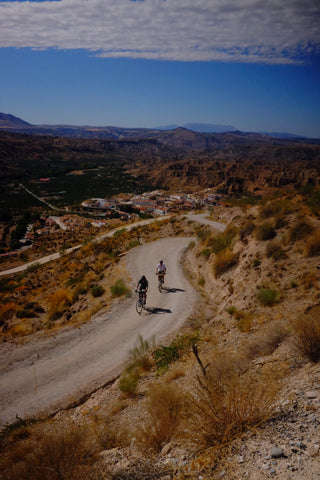Ghosts of the Badlands
Oct 05, 2022
This is probably a good spot. What’s that pillar, I think it’s a gravestone? Fuck. Let’s keep looking. It’s 2:00 am and after 18 hours of pedaling, it was time to take a rest longer than 30 minutes. The resupply we desperately needed wouldn’t be open for another six hours and we were still two hours away from it, so might as well sleep.



In its third edition and fully sold out, Badlands starts in Granada, Spain covering 780 kilometers and over 15,000 metres of elevation through some of the most remote, diverse and challenging landscapes in Europe; the forests of Sierra de Huétor, the deserts of Gorafe and Tabernas, the wild coasts of Cabo de Gata, the steep climbs of La Alpujarra and finishing in the highest village in Spain, Capileria. Long remote sections of the parkour demand smart planning and strategic resupplies. The first 450 kilometers of the course had villages with only a single option for food and varying hours of operation, making timing critically important. If you made it to the resupply while it was open, you could continue forward. If you didn’t, you waited until it was. I signed up this event in late December, 2021 with my good friend and teammate Sean Martin, looking to do something, new, big and challenging. He had never done an Ultra and I had finished two up to that point. We decide to race as a pair; combining my limited experience and his sheer determination to finish after a scratch earlier in 2022. We had sights of doing our best and finishing in under three days in our first European race in over three years.
“If you ride at night, you’ll miss a ton of the scenery.” Someone told me this before we departed on this trip, and they were right. It’s a long way to go to miss the epic views on such a varying and beautiful landscape, but it’s just the reality of racing these types of events. Even during the daytime, you might miss something, between making sure you’re eating, checking your map and thinking about your next break. These races have a way of breaking you down to your animalistic self, thinking of little more than food, water and resting. The night moves and dawn patrols were some of the most memorable moments for me. From stunning cotton candy sunrises as we crested Collado Colativi, to following blinking taillights in complete darkness in the middle of the night. Floating in the distance, like orbs in the sky disappearing around bends only to appear again and alternating between the rear and front lights, letting you know there was much more to climb. Those tunnel-visioned images are forever burned into my memory. In the end, as we spoke to other racers and mentioned things we saw or didn’t see, it’s clear that everyone takes home a little different part of the course home with them in memory.


Wasn’t all survival, loneliness in the dark and running out of food and water (not for us at least). There was camaraderie, moments of sheer bliss, and overwhelming appreciation for estranged creature comforts. A bed after sleeping in an irrigation ditch, a shower after cleaning yourself with a wet wipe, a warm meal after carrying a cold bocadillo for half a day. The small things that flip your mental state from wanting to scratch to feeling like you could ride another 200 kilometers without stopping. The respite during the resupplies was a definite highlight, after all, most Ultras are races of eating and not sleeping. In some cases, we would pedal non-stop until the resupply, having a hard stop lunch after 4-5 hours of riding. The stops were reminiscent of the early days of the Tour De France; dozens of famished racers coming into a town, ordering everything in sight and consuming it immediately, frantically stuffing their pockets to take some on the go. Bikes lined the narrow streets with racers sitting on the floor eating, drinking and taking a rest. Locals look on, confused and intrigued by the commotion, some yelling “Venga Venga” as riders rolled in and others rolled out.
But not everyone was in such a rush, and we were in Spain, so we did as the Spanish do and we took our time. After two days of pushing hard, four hours of total sleep and covering two-thirds of the race, the goal shifted a bit to enjoying ourselves while pushing towards a sub-96-hour finish. Our first sit-down meal came some 50-odd hours into the race, as we finally reached the Bay of Almeria on the southeastern Mediterranean Coast. One beer turned into three, as gnocchi plates, salad, patatas and pizza arrived at our small table, filling the surface entirely as it did our stomachs. This would be the shortest and easiest day of the race so far for us, only riding 144 km with 1859 meters of gain. We made the call to finish early, get a hotel, sleep in a bed and do a mega push to the finish the following day.
It’s a fine line between being as competitive as your ability and trying to enjoy yourself while doing it. I’ve never been a prolific winner, but I’ve won things in the past that I’m proud of and I continue to chase the dragon. Results may not always be within reach but creating your own experience out on the road will always be. The older I get and the more I put myself out there, the more I value the experiences on the road more than the results themselves. Badlands was the perfect combination of the two for me. The difficulty of the course made it inevitable that you’d need to push hard, tackling huge mountain passes and long desert stretches, while the beauty of it all reminded you to slow down for a second and take it in. “Dot watching” or spectating online via following GPS trackers is a way for friends, family and fans of Ultra Racing to interact with racers in real-time. Each rider is a dot on a map, allowing anyone to track your progress. Sending messages of encouragement, telling you what position you’re in, to even alerting you that you’re lost. (Thanks Bobby Endo, you saved Sean!) This dynamic also changes the way you compete; by always knowing where your competition is you can rest while they rest, ride while they ride, ride while they rest or vice versa. You can check the dots religiously or never check them at all.

Sleeping in a hotel during a race comes with unique challenges; it’s comfortable and warm so you don’t want to leave, as opposed to waking up on the ground outside cold and getting moving ASAP to get warm. It’s 3:30 am in Almeria and on the schedule is 206 kilometers with 5,700 meters of climbing to get to the finish. Dots are checked, and we’re in the top 10 again as most pairs also stopped in Almeria for the night. At this point only four pairs had finished, some 68 hours in. We’re immediately on the rocky harsh slope of Los Pedrolos, one of the three tough Cols we would be riding that day. Covering 95 kilometers and 2,578 meters before noon, and leapfrogging ninth and 10th place, we took a prolonged lunch break before the hardest part of the race; La Alpujarra. There’s something bittersweet about finishing an event like this. You want to finish because you’re incredibly fatigued, but you don’t want the adventure to come to an end. Not thinking about work, what day it was or anything else except what you were doing in that moment is a rare opportunity. With the last 55 kilometers covering 2,100 meters of elevation gain, we would have a few hours before the end of our adventure.
Ultra races are all unique in their own way in terms of terrain, length, remoteness and general difficulty. The thing that keeps most of them the same is a set of rules of self-sufficiency and all the values conveyed by Mike Hall and his legacy. No prize money or prizes, just the satisfaction that you prevailed, and even if you didn’t win, the satisfaction that you finished. Depending on what time you finish, there could be other racers, friends or family waiting to congratulate you, or there could be no one at all. After a late dinner at the base of the last climb, we connected with a few other racers we had been leapfrogging with the entire race; Sam Maunder and Chris Hall. We celebrated a little, with patatas, croquetas de jamon and fried eggs. Some beverages of the adult variety were also consumed, briefly subsiding the thoughts of the upcoming final climb. We caravanned up the climb in the darkness, not able to see where the road led. Excited to finish, full of nourishment and slightly inebriated, the conversations were lively, loud and encouraging, but they slowed as the road continued upwards.
My Garmin marked the final climb on the entire 780 kilometer route; a 2-km stretch of 3% average gradient. It was the hardest climb of the race for me. Maybe I didn’t want it to end, making it last longer than it needed to, I’m not sure. Like every village we entered during the entire race, we were treated to an amazing descent with the town’s lights in the distance. It was 2 am, and after 90 hours of riding, we had covered the 780-kilometer, 15,000-meter course that is Badlands. With only the hostel operator at the finish to hand us our medals and offer us a room, we all hugged each other and lay on the ground. Everything was closed, no finishing meal or beer was to be had, so we went to bed hungry. We met our goal, finished in 11th, made lifelong memories, and finished hungry. Hungry to get out there and do it all over again.



